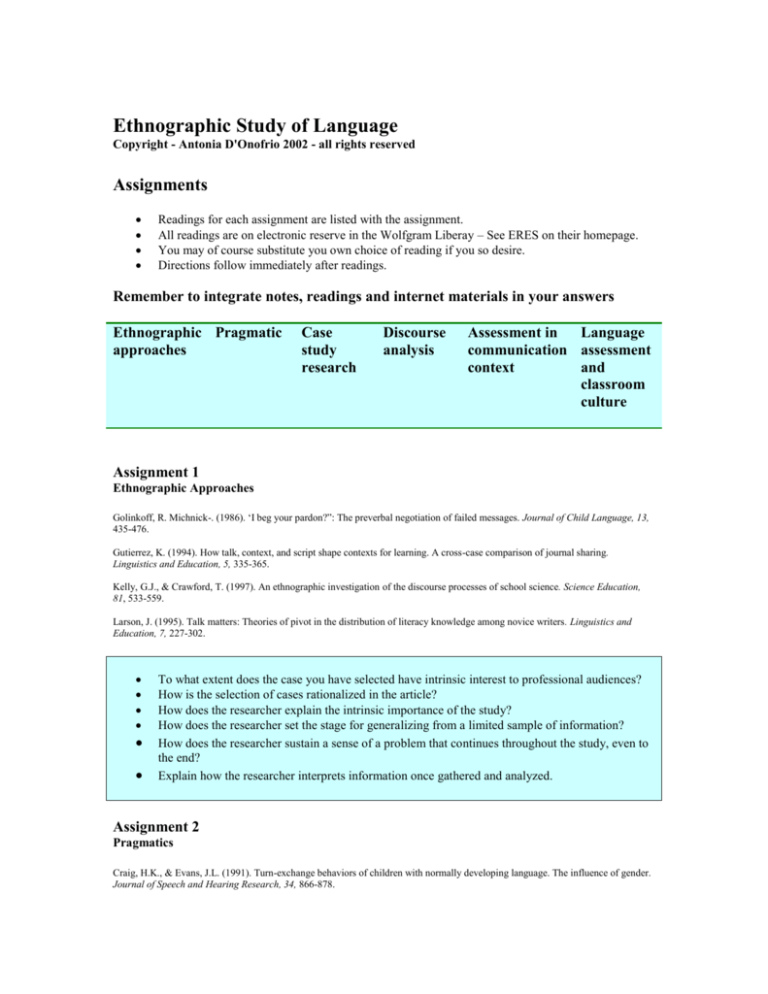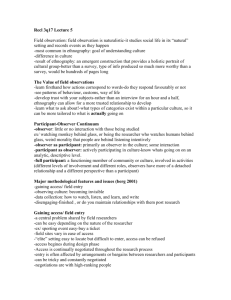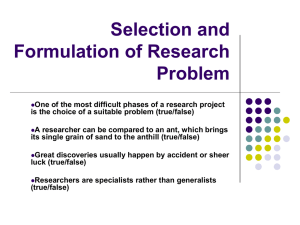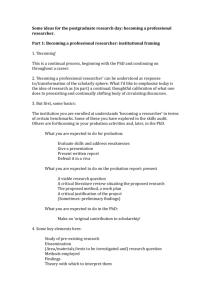
Ethnographic Study of Language
Copyright - Antonia D'Onofrio 2002 - all rights reserved
Assignments
Readings for each assignment are listed with the assignment.
All readings are on electronic reserve in the Wolfgram Liberay – See ERES on their homepage.
You may of course substitute you own choice of reading if you so desire.
Directions follow immediately after readings.
Remember to integrate notes, readings and internet materials in your answers
Ethnographic Pragmatic
approaches
Case
study
research
Discourse
analysis
Assessment in
Language
communication assessment
context
and
classroom
culture
Assignment 1
Ethnographic Approaches
Golinkoff, R. Michnick-. (1986). ‘I beg your pardon?”: The preverbal negotiation of failed messages. Journal of Child Language, 13,
435-476.
Gutierrez, K. (1994). How talk, context, and script shape contexts for learning. A cross-case comparison of journal sharing.
Linguistics and Education, 5, 335-365.
Kelly, G.J., & Crawford, T. (1997). An ethnographic investigation of the discourse processes of school science. Science Education,
81, 533-559.
Larson, J. (1995). Talk matters: Theories of pivot in the distribution of literacy knowledge among novice writers. Linguistics and
Education, 7, 227-302.
To what extent does the case you have selected have intrinsic interest to professional audiences?
How is the selection of cases rationalized in the article?
How does the researcher explain the intrinsic importance of the study?
How does the researcher set the stage for generalizing from a limited sample of information?
How does the researcher sustain a sense of a problem that continues throughout the study, even to
the end?
Explain how the researcher interprets information once gathered and analyzed.
Assignment 2
Pragmatics
Craig, H.K., & Evans, J.L. (1991). Turn-exchange behaviors of children with normally developing language. The influence of gender.
Journal of Speech and Hearing Research, 34, 866-878.
Craig, H.K., & Evans, J. L. (1993). Pragmatics and SLI: Within-group variations in discourse behaviors, Journal of Speech and
Hearing Research, 36, 777-789.
Golinkoff, R. Michnick-. (1986). ‘I beg your pardon?”: The preverbal negotiation of failed messages. Journal of Child Language, 13,
435-476.
Gutierrez, K. (1994). How talk, context, and script shape contexts for learning. A cross-case comparison of journal sharing.
Linguistics and Education, 5, 335-365.
Morgan, J. (1993). Pragmatic language in early childhood education: Behavior and thought in teaching. (Paper presented at the Annual
Meting of the American Educational Research Association), Atlanta, GA (ERIC Document Reproduction Service No. ED 389 437).
Was a conceptual framework created that helped you to formulate the communication issues that
were important to the research problem?
Were there additional questions about language use in context that you would have asked?
Did new issues surface for you after the first reading of the article. Which ones?
How did the researcher handle the evolution of pragmatic points of focus through sequencing of
speech events and interpretation?
What challenges to interpretation would be presented by any new evidence that you were able to
find in the study?
Explain your answers.
Assignment 3
Case study methods
Any item on the reading list in bold font is suitable for this assignment
Is background data/information used in a way that aids the interpretation appearing later in the
article? Does it provide grounding for the interpretation?
Are the case study strategies described in a helpful way?
Does the researcher provide personal information that assists in understanding the significance of
the research problem?
Has the researcher described his/her personal relationship with the problem? Clarification is
important. How well did the researcher describe personal involvement, distance as an observer,
expertise with the problem and investigative tools, decisions regarding the telling of story, and the
degree to which faculty and interpretive activity has been balanced?
Explain your answers.
Assignment 4
Discourse analysis
Coming soon – I still haven’t figured out how to get my raw transcripts onto web format
the way I want them.
Won’t be long.
Assignment 5
Assessment in context
This assignment will make more sense once you have an opportunity to look at the ways
in which student performance during reciprocal reading can be studied using informal
observation tools.
Use this web page to help with assignment 5 – I have linked an electronic story and
started the process of developing an inventory based on the story.
Creativity counts in this assignment. We will be using reciprocal reading as a way to conduct informal
assessment. A variety of dimensions of linguistic competence play a role n reciprocal reading, and these
dimensions can become the basis for informal assessment on several planes. These include cognitive as
well as linguistic abilities, such as semantic competence and awareness of communicative strategy.
For starters, investigate this web site. It is located in the web pages of a literature professor who looks at
reciprocal reading from the perspective of literature and literacy. Many of the issues identified on the site
speak to a readers understanding of reality, experience, language and reader/writer roles, to name only a
few. Now think expansively. How does reciprocal reading mirror the literary process of reader-response?
Can we build a diagnostic profile of a reader using the reader response dimensions, and base the profile on
a reciprocal book reading activity? Here is the site
I hope you said YES.
I did most of this for you already. Create a vignette of a reader in a classroom situation? Describe the
reciprocal reading activity. Link the student’s performance to reader response dimensions of awareness.
What would be the content of that assessment? How would you design an observational checklist to
capture the reader-response dimensions? Of course it is important in your response to be specific about the
age of the child, reading level, and genre of reading materials?
Assignment 6
Language assessment and
classroom culture
DeCarlo, M.J.T. (1994). Communicative functions of speech in a monolingual kindergarten. Working Papers in Educational
Linguistics, 10, 22-31.
Doig, B. (1997). What makes scientific dialog possible in the classroom? Paper presented at the Annual Meeting of the American
Educatonal Research Association), Chicago, IL (ERIC Document Reproduction Service No. ED 413 246).
Dorr-Bremme, D.W. (1990). Contextualization cues in the classroom: Discourse regulation and social control functions. Language in
Society, 19, 379-402.
Fisher, E. (1993). Distinctive features of pupil-pupil, classroom talk and their relationship to learning how discursive exploration
might be encouraged. Language and Education, 7, 239-257.
Lee, O., & Fradd, S.H. (1996). Interactional patterns of linguistically diverse students and teachers. Insights for promoting science
learning. Linguistics and Education, 8, 269-297.
Purcell, S.L., & Liles, B.Z. (1992). Cohesion repairs in the narratives of normal language and language disorders school age children.
Journal of Speech and Hearing Research, 35, 354-362.
Skrakis-Doyle, & Murphy, L. (1995). Discourse-based language intervention: An efficacy study. Journal of Children’s
Communication Development, 17, 11-22.
How was a sense of context developed?
How does the case attempt to understand rather than to compare and contrast case material with
other research reports?
How are boundaries for the study developed?
Did the case focus on problem centered events and try to make sense of them?
Does subject intentionality receive sufficient attention?
Has raw data been juxtaposed with interpretation?
Explain your answers.
return home










